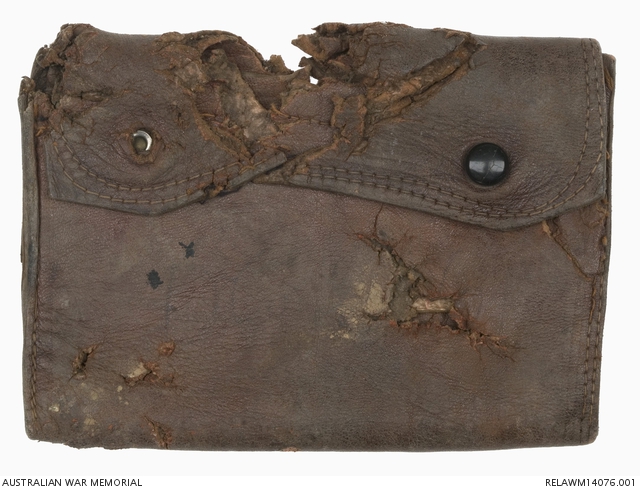| Place | Europe: France, Picardie, Somme |
|---|---|
| Accession Number | RELAWM14076.001 |
| Collection type | Heraldry |
| Object type | Heraldry |
| Physical description | Leather |
| Maker |
Unknown |
| Place made | Australia |
| Date made | c 1915 |
| Conflict |
First World War, 1914-1918 |
Wallet : Private C J Brill, 56 Battalion AIF


Rectangular brown leather three-fold wallet, secured shut by two press studs (one press stud is damaged). The interior of the wallet is lined with leather. Each side of the interior is fitted with two pockets, running the length of the wallet (one behind the other). In the centre is a small loop of leather to hold a pen or pencil. The wallet has been damaged by shell fragments and has many holes. The owner's details are hand written on the back in blue or black ink, some of which is illegible due to wear or shell damage. It reads '30[09] / C J BRILL / ...CRAIGIE / 4th BATT N S WALES'.
Wallet taken from the pocket of 3009 Private Clarence James 'Jim' Brill after he was killed in 1917. Brill was born at Mooroopna, Victoria, the son of Joseph and Kitty Brill. He was almost 28 years old and living at Craigie, NSW when he enlisted in the AIF on 13 July 1915, and was then working as a sawyer in a local saw mill.
Known as 'Snow' to his mates in the AIF, he embarked at Sydney with the 10th reinforcements to 4 Battalion in HMAT Warilda, on 8 October 1915. He joined his battalion at Tel el Kebir in Egypt in January 1916. In February Brill was transferred to the newly formed 56th Battalion. On 19 June he embarked for France in HT Huntsend, arriving at Marseilles ten days later. He remained with his battalion on the Western Front and was with the battalion every time it went into the front line.
On 14 March 1917 the unit was in the lines at the Somme. Brill was doing engineers' work just behind the front line with his friend 3114 Private John Richard 'Spinkie' Spinks and another man, when their location was hit by German artillery fire. A shell fell between the three men, killing Brill instantly and wounding Spinks and the other man. Shrapnel hit Spinks around the forehead and eyes, blinding him. He was unable to see what had happened to Brill, but shouted for him and tried to find him. Another soldier found Spinks wandering around in shock and Spinks asked him to look for Brill.
Spinks was eventually sent to 3 General Hospital in England. There he received a letter telling him that Brill had been killed by the shell that had blinded him. The only casualties for the battalion that day were due to this shell. Brill was buried at a small cemetery behind Needle Trench, near Lesboeufs, France. Chaplain Alexander Sydney Greville officiated and his friends from the battalion attended. In the 1920s his body was exhumed and reburied at the Guards Cemetery at Lesbouefs.
This wallet was one of several items returned by the army to Brill's mother at Craigie, NSW in November 1917. Brill had it when he served with 4 Battalion, and later 56 Battalion and was carrying it when he died. At the time it contained a number of items including his pocket book (RELAWM14076.002) and a photograph of a young woman, called Gladys (RELAWM14076.006). Both items also sustained damage from the shell. Brill's brother Leslie also served in the AIF and was awarded the Military Medal for his work as a stretcher bearer and in dressing stations at Gallipoli in 1915.
- Pocket book : Private C J Brill, 56 Battalion AIF
- Rising Sun hat badge : Private C J Brill, 56 Battalion AIF
- 56 Battalion colour patch : Private C J Brill, 56 Battalion AIF
- Souvenir Australian red ensign : Private C J Brill, 56 Battalion AIF
- Photograph of 'Gladys' : Private C J Brill, 56 Battalion AIF
- Deceased Soldier's Kit tag : Private C J Brill, 56 Battalion AIF